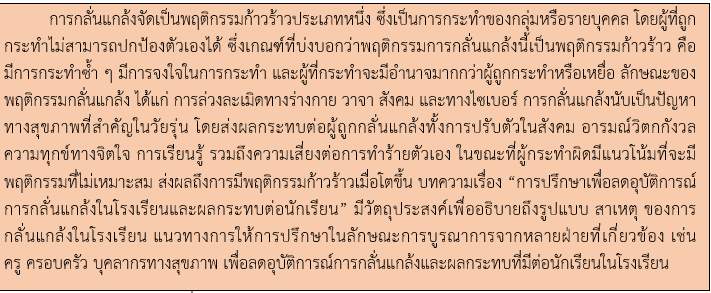การให้ปรึกษาเพื่อลดอุบัติการณ์การกลั่นแกล้งในโรงเรียนและผลกระทบต่อนักเรียน
คำสำคัญ:
การปรึกษา, การกลั่นแกล้ง, นักเรียนบทคัดย่อ
การกลั่นแกล้งจัดเป็นพฤติกรรมก้าวร้าวประเภทหนึ่ง ซึ่งเป็นการกระทำของกลุ่มหรือรายบุคคล โดยผู้ที่ถูกกระทำไม่สามารถปกป้องตัวเองได้ ซึ่งเกณฑ์ที่บ่งบอกว่าพฤติกรรมการกลั่นแกล้งนี้เป็นพฤติกรรมก้าวร้าว คือ มีการกระทำซ้ำ ๆ มีการจงใจในการกระทำ และผู้ที่กระทำจะมีอำนาจมากกว่าผู้ถูกกระทำหรือเหยื่อ ลักษณะของพฤติกรรมกลั่นแกล้ง ได้แก่ การล่วงละเมิดทางร่างกาย วาจา สังคม และทางไซเบอร์ การกลั่นแกล้งนับเป็นปัญหาทางสุขภาพที่สำคัญในวัยรุ่น โดยส่งผลกระทบต่อผู้ถูกกลั่นแกล้งทั้งการปรับตัวในสังคม อารมณ์วิตกกังวล ความทุกข์ทางจิตใจ การเรียนรู้ รวมถึงความเสี่ยงต่อการทำร้ายตัวเอง ในขณะที่ผู้กระทำผิดมีแนวโน้มที่จะมีพฤติกรรมที่ไม่เหมาะสม ส่งผลถึงการมีพฤติกรรมก้าวร้าวเมื่อโตขึ้น บทความเรื่อง “การปรึกษาเพื่อลดอุบัติการณ์การกลั่นแกล้งในโรงเรียนและผลกระทบต่อนักเรียน” มีวัตถุประสงค์เพื่ออธิบายถึงรูปแบบ สาเหตุ ของการกลั่นแกล้งในโรงเรียน แนวทางการให้การปรึกษาในลักษณะการบูรณาการจากหลายฝ่ายที่เกี่ยวข้อง เช่น ครู ครอบครัว บุคลากรทางสุขภาพ เพื่อลดอุบัติการณ์การกลั่นแกล้งและผลกระทบที่มีต่อนักเรียนในโรงเรียน
เอกสารอ้างอิง
Alex-Hart, B. A., Okagua, J., & Opara, P. I. (2015). Prevalence of bullying in secondary schools in Port Har court. International Journal of Adolescent Medicine and Health, 27(4), 391–396. www.http://dx.doi.org/10.1515/ijamh-2014-0038.
Arslan, G., Allen, K. A., & Tanhan, A. (2021). School bullying, mental health, and wellbeing in adolescents: Mediating impact of positive psychological orientations. Child Indicators Research, 14, 1007-1026.
Bandura, A. (1986). Social foundations of thought and action: A social cognitive theory. New Jersey: Prentice-Hall.
Betts, L. R., Spenser, K. A., & Gardner, S. E. (2017). Adolescents’ involvement in cyber bullying and perceptions of school: The importance of perceived peer acceptance for female adolescents. Sex roles, 77, 471-481.
Bronfenbrenner, U. (1994). Ecological models of human development. In T. Husen & T. N. Postlethwaite (Eds.), International Encyclopedia of Education. (2nd ed.). Oxford: Elsevier Science.
Cecen-Celik, H., & Keith, S. (2019). Analyzing predictors of bullying victimization with routine activity and social bond perspectives. Journal of Interpersonal Violence, 34(18), 3807-3832.
Cornell, D., & Limber, S. P. (2015). Law and policy on the concept of bullying at school. American Psychologist, 70(4), 333–343.
Department of Mental Health (2020). Thailand ranks 2nd for “Children bullying in schools” with 600,000 victims per year. Retrieved September 3, 2024 from www.https://dmh.go.th/news-dmh/view.asp?id=27485 (in Thai)
Espelage, D. L., & Holt, M. K. (2013). Suicidal ideation and school bullying experiences after controlling for depression and delinquency. Journal of Adolescent Health, 53(1), S27-S31.
Hewitt, J. P., & Shulman, D. (2011). Self and society: A symbolic interactionist social psychology. (11th ed.). Boston, MA: Pearson. Hymel, S., & Swearer, S. M. (2015). Four decades of research on school bullying: an introduction. American Psychologist, 293–299. www.http://dx doi:10.1037/a0038928.
Jia, M., & Mikami, A. Y. (2014). Peer preference and friendship quantity in children with externalizing behavior: Distinct in fluences on bully status and victim status. Journal of Abnormal Child Psychology, 43(5), 957–969. www.http://dx.doi.org/10.1007/s10802-014- 9956-8.
Juvonen, J., Wang, Y., & Espinoza, G. (2011). Bullying experiences and compromised academic performance across middle school grades. The Journal of Early Adolescence, 31(1), 152–173. www.http://dx.doi.org/10.1177/0272431610379415.
Källmén, H., & Hallgren, M. (2021). Bullying at school and mental health problems among adolescents: a repeated cross-sectional study. Child and adolescent psychiatry and mental health, 15, 1-7.
Lemstra, M. E., Nielsen, G., Rogers, M. R., Thompson, A. T., & Moraros, J. S. (2012). Risk indicators and outcomes associated with bullying in youth aged 9–15 years. Canadian Journal of Public Health, 103, 9-13.
Menesini, E., & Salmivalli, C. (2017). Bullying in schools: The state of knowledge and effective interventions. Psychology, Health & Medicine, 22(sup1), 240-253. www.https://doi.org/10.1080/13548506.2017.1279740.
Mucherah, W., Finch, H., White, T., & Thomas, K. (2018). The relationship of school climate, teacher defending and friends on students' perceptions of bullying in high school. Journal of adolescence, 62, 128-139.
Olthof, T., & Goossens, F. A. (2008). Bullying and the need to belong: Early adolescents' bullying-related behavior and the acceptance they desire and receive from particular classmates. Social Development, 17(1), 24–46. www.http://dx.doi.org/10.1111/j.1467- 9507.2007.00413.x.
Olweus, D. (1997). Bully/victim problems in school: Facts and intervention. European journal of psychology of education, 12, 495-510.
Olweus, D. (2013). School bullying: development and some important challenges. Annual Review of Clinical Psychology, 9, 751–780.
Olweus, D., & Limber, S. P. (2018). Bullying in school: Evaluation and dissemination of the Olweus Bullying Prevention Program. American Journal of Orthopsychiatry, 88(4), 423– 432. https://doi.org/10.1037/ort0000301
Rose, C. A., Espelage, D. L., Monda-Amaya, L. E., Shogren, K. A., & Aragon, S. R. (2015). Bullying and middle school students with and without specific learning disabilities: An examination of social-ecological predictors. Journal of learning disabilities, 48(3), 239- 254.
Seals, D., & Young, J. (2003). Bullying and victimization: prevalence and relationship to gender, grade level, ethnicity, self-esteem, and depression. Adolescence, 38(152).
Steinmayr, R., Crede, J., McElvany, N., & Wirthwein, L. (2016). Subjective well-being, test anxiety, academic achievement: Testing for reciprocal effects. Frontiers in Psychology, 6, 1994.
Swearer, S., & Espelage, D. (2011). A social-ecological framework of bullying among youth in North American schools.NewYork: Routledge.
Thornberg, R., & Delby, H. (2019). How do secondary school students explain bullying. Educational Research, 61(2), 142-160.
United Nations Children’s Fund. (2018). UNICEF Annual Report 2017. Retrieved August 1, 2024 from https://www.unicef.org/reports/unicef-annual-report-2017.
United Nations Educational Scientific and Cultural Organization. (2019). Behind the numbers: Ending school violence and bullying. Retrieved September 3, 2024 from www.https://unesdoc.unesco.org/ark:/ 48223/pf0000366483.
Wachs, S., Bilz, L., Fischer, S. M., Schubarth, W., & Wright, M. F. (2018). Students’ willingness to intervene in bullying: Direct and indirect associations with classroom cohesion and self- efficacy. International Journal of Environmental Research and Public Health, 15(11), 2577.
World Health Organization. (2002). World Report on Violence and Health. Geneva. Retrieved September 3, 2024 from www.https://www.who.int/publications/i/item/9241545615.
Zych, I., Ttofi, M. M., & Farrington, D. P. (2019). Protective factors against bullying and cyberbullying: A systematic review of meta-analyses. Aggression and Violent Behavior, 45, 4-19. https://doi.org/10.1016/j.avb.2018.06.008.

ดาวน์โหลด
เผยแพร่แล้ว
รูปแบบการอ้างอิง
ฉบับ
ประเภทบทความ
สัญญาอนุญาต
ลิขสิทธิ์ (c) 2024 วิทยาลัยพยาบาลบรมราชชนนี นครศรีธรรมราช

อนุญาตภายใต้เงื่อนไข Creative Commons Attribution-NonCommercial-NoDerivatives 4.0 International License.
บทความที่ได้รับการตีพิมพ์เป็นลิขสิทธิ์ของ วิทยาลัยพยาบาลบรมราชชนนี นครศรีธรรมราช
ข้อความที่ปรากฏในบทความแต่ละเรื่องในวารสารวิชาการเล่มนี้เป็นความคิดเห็นส่วนตัวของผู้เขียนแต่ละท่านไม่เกี่ยวข้องกับวิทยาลัยพยาบาลบรมราชชนนี นครศรีธรรมราช และบุคคลากรท่านอื่น ๆ ในวิทยาลัยฯ แต่อย่างใด ความรับผิดชอบองค์ประกอบทั้งหมดของบทความแต่ละเรื่องเป็นของผู้เขียนแต่ละท่าน หากมีความผิดพลาดใดๆ ผู้เขียนแต่ละท่านจะรับผิดชอบบทความของตนเองแต่ผู้เดียว





